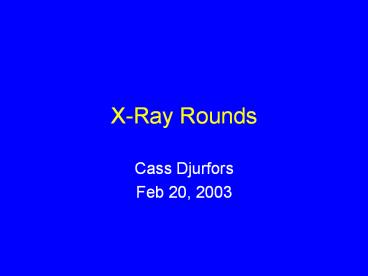X-Ray Rounds - PowerPoint PPT Presentation
1 / 19
Title:
X-Ray Rounds
Description:
X-Ray Rounds Cass Djurfors Feb 20, 2003 10 y.o. boy with leg pain Obese 10-year old male presents with a two week history of right thigh and knee pain. – PowerPoint PPT presentation
Number of Views:52
Avg rating:3.0/5.0
Title: X-Ray Rounds
1
X-Ray Rounds
- Cass Djurfors
- Feb 20, 2003
2
10 y.o. boy with leg pain
- Obese 10-year old male presents with a two week
history of right thigh and knee pain. - He states that the pain is mainly in his thigh
(points to his upper thigh) but radiates down to
his knee.
3
10 y.o. boy with leg pain
- He was playing basketball when he collided with
another player and fell. He noted severe pain in
his thigh and had to limp home, mostly on his
left leg. - The pain is worse with weight-bearing and much
better when lying in bed. - No history of fever, rash, chest discomfort, or
pains in other joints.
4
On Exam
- Vitals
- T37.0 (oral)
- P66
- R20
- BP 112/65
- weight 69.3 kg (gtgt95th percentile)
- height 152 cm (gt95th percentile)
- Alert, cooperative, in no distress
- Head and neck, CVS, Respiratory and Abdominal
exam all normal
5
On Exam
- Right lower extremity
- Moderate tenderness in the upper anterior thigh
- Severely tender in the hip, ROM not done
- Pubic symphysis, mid thigh, knee, tibia/fibula
all non tender - No joint swelling
- ROM knee normal
- Left lower extremity
- Non-tender, normal exam
6
(No Transcript)
7
And the answer isSCFE!
- Hip radiographs show a slipped capital femoral
epiphysis on the right - Left hip appears normal (but difficult to rule
out an early slip)
8
SCFE
- The radiographic diagnosis of slipped capital
femoral epiphysis (SCFE) can be subtle - In this case, the physis appears to be wider and
more lucent in the patient's right hip compared
to his left - The position of the femoral head epiphysis should
resemble a cap over the physis - Subtle cases may just show a slight
malpositioning of the epiphysis
9
- Klein line a line drawn along the superior
border of the proximal femoral metaphysis should
intersect part of the proximal femoral epiphysis - In this patient, right hip shows the line just
touching the lateral margin of the epiphysis
this is abnormal and indicates that the femoral
capital epiphysis has slipped inferiorly and
medially - The patient's normal left hip shows the line
intersecting the lateral part of the femoral
epiphysis
10
Management
- Patient is hospitalized and put on bedrest
- He is taken to the operating room for internal
fixation of his right capital femoral epiphysis.
11
Much more obvious
12
- Severe left slipped capital femoral epiphysis
- The slipped capital femoral epiphysis on the
right is not as obvious - This patient has bilateral SCFE, severe on the
left, and moderate on the right
13
SCFE
- Presents with acute, subacute, or chronic pain in
the hip, thigh, or knee - Ambulatory ability may range from non-weight
bearing to a normal gait - Most comfortable with hip externally rotated
- Unable to fully internally rotate affected hip
14
SCFE
- Occurs during adolescent growth spurt
- Most frequent in obese children
- 40-80 are bilateral
- Classification emphasizes epiphyseal stability
- Stableambulation possible
- Unstableambulation impossibledo not attempt
passive ROM on exam for fear of further slip - Mild/Mod/Severe 1/3, ½, gt1/2
- 90 are stable good prognosis if diagnosed early
- Unstable SCFE has a much poorer prognosis due to
high risk of avascular necrosis
15
Diagnosis
- SCFE can be detected radiographically in most
instances - AP views show only inferior and medial slips
- Early slips tend to be posteriorbest seen on
lateral x-ray - CT scanning can be helpful, but is not usually
needed in the emergency department - Obvious cases are hard to miss
16
Diagnosis
- Subtle cases
- Widened or irregular epiphyseal plate (compare to
opposite side) - The physis may alternatively appear thinner than
the normal side (esp with posterior slips) - A line drawn along the superior border of the
metaphysis (the Klein line) will intersect less
of the epiphysis compared to the normal side - The blanch sign of Steel (AP view)
crescent-shaped area of increased density
represents superimposition of the posteriorly
displaced epiphysis on the femoral neck
17
Treatment
- Ensure child is non weight-bearing
- Orthopedic referral
- Most are fixed with a single central screw
18
(No Transcript)
19
(No Transcript)

